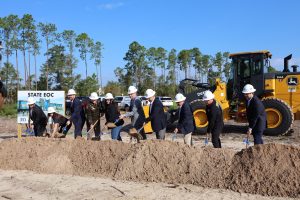Plus RMS hurricane model changes
The state of Florida is creating a new state emergency operations center from the ground up, some insight on Moody’s latest RMS hurricane model and how it will impact insurance ratemaking, plus the federal government is now making rural disaster home repair grants available from last year’s hurricanes. It’s all in this week’s Disaster Management Digest.

Ceremonial groundbreaking for the new State Emergency Operations Center, September 20, 2023. Courtesy, FDEM
New EOC: The Florida Division of Emergency Management (FDEM) recently broke ground on a new $180 million state Emergency Operations Center (EOC), one that will be able to withstand the toughest hurricanes. “We just saw Hurricane Idalia narrowly miss a direct hit on Tallahassee,” FDEM Chief Kevin Guthrie told the Tallahassee Democrat. “We need an EOC that can withstand up to 200 miles an hour winds, well over a Category 5 wind speed.” He said the current center, located just down the block from where its replacement is being built in southeast Tallahassee, has long outgrown emergency operations requirements. It was built after Hurricane Andrew in 1992 and designed for 200 people. Today it often hosts more than 400 professionals from various state and federal agencies that help coordinate statewide disaster preparation and recovery.
 RMS Model Changes: Reinsurance broker and analyst Gallagher Re recently held an interesting webinar explaining the changes in Moody’s latest Risk Management Services (RMS) hurricane model and the impact on business applications for ratemaking. Prasad Gunturi, their Global Co-Head of Model Research & Evaluation said the most noticeable difference in Version 23 of the model is the difference the construction material makes. He said recent hurricanes’ damage observed in wood frame construction is increasing by 10% to 20%. Light metal construction though, whether personal lines or commercial lines, are increasing “significantly” more – by almost 300% in the case of commercial occupancies.
RMS Model Changes: Reinsurance broker and analyst Gallagher Re recently held an interesting webinar explaining the changes in Moody’s latest Risk Management Services (RMS) hurricane model and the impact on business applications for ratemaking. Prasad Gunturi, their Global Co-Head of Model Research & Evaluation said the most noticeable difference in Version 23 of the model is the difference the construction material makes. He said recent hurricanes’ damage observed in wood frame construction is increasing by 10% to 20%. Light metal construction though, whether personal lines or commercial lines, are increasing “significantly” more – by almost 300% in the case of commercial occupancies.
“Light metal construction is actually treated much more like a mobile home these days within the model,” Gunturi explained. “That’s why you’re seeing the increase. So are we surprised by that? Probably not. Based on the damage surveys that we did right after Hurricane Irma, Ian, and Michael, we found numerous examples of light metal constructions that are being damaged heavily, much more so than a single family dwelling in particular.” He said part of the reason was lighter frames and a larger number of openings. “So they tend to be more damageable to hurricane forces either due to uplift or to the twisting of it,” Gunturi said.

An AmeriCorps Disaster Response Team removes damaged flooring from a flooded home on Pine Island, Florida after Hurricane Ian, November 29, 2022. Courtesy, AmeriCorps
Disaster Home Repair Grants: The U.S. Department of Agriculture (USDA) recently announced the availability of grants to repair homes damaged in 2022 in a Presidentially Declared Disaster Area. Through the Single Family Housing Rural Disaster Home Repair Grants program, eligible very-low and low-income homeowners, as determined by the USDA, can receive grants up to $40,675. Properties must be located in an eligible rural area. Funds can be used on disaster related home repair expenses, including costs incurred prior to applying; site preparation; and the cost to transfer a manufactured home. Applications are accepted year-round until funding is no longer available. To get started, residents can contact a local USDA home loan specialist. For more information, click here.
LMA Newsletter of 10-9-23

